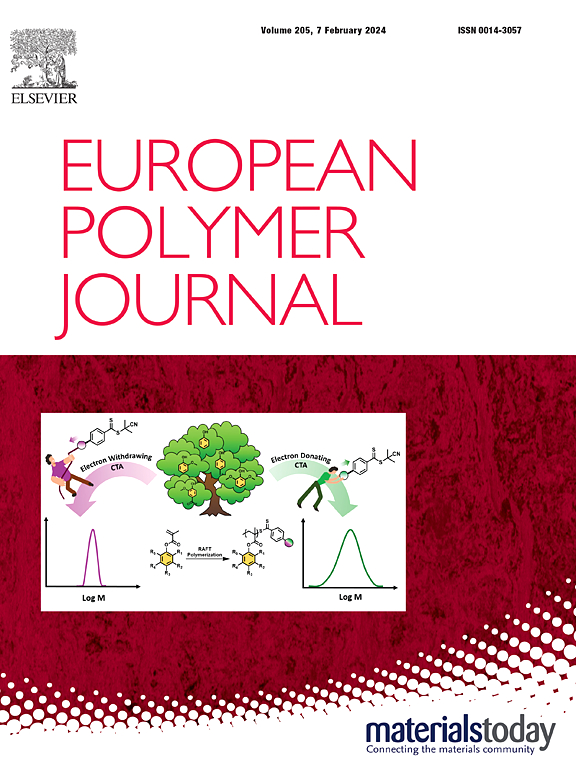Development of novel coordination polymeric metal complexes with potent antimicrobial and antitumor activity
IF 5.8
2区 化学
Q1 POLYMER SCIENCE
引用次数: 0
Abstract
The development of novel multi-target compounds with multiple therapeutic applications represents an excellent strategy for replacing the drug combination approach. Such strategy is beneficial in reducing or preventing the side effects of the combined drugs. Organometallic complexes, particularly those with polymeric structures, demonstrate dual functionality against microbial pathogens and tumor cells. Herein, a new series of polymeric metal complexes with strong antitumor and antimicrobial activity was developed. First, two novel coordination polymers (CP1 and CP2) were synthesized through exchanging the active phthalimidoxy moiety in poly N-methacyloxyphthalimide [poly(NMPI)] with two Schiff base derivatives (S1 and S2). Then, four polymeric metal complexes were constructed by coordinating CP1 and CP2 with copper and nickel acetates, and their chemical compositions were deduced based on various spectroscopic tools. Additionally, the thermal behavior of complexes was investigated by thermogravimetric analysis while their geometries were calculated via molecular modeling. The results of the antimicrobial activity revealed that almost all complexes possess excellent antifungal and antibacterial efficiency against the selected pathogens. Simultaneously, the cytotoxicity potency of the coordination polymers and their complexes was evaluated against human cancer (HepG2) and normal (WI-38) cell lines. The results exhibited that Ni-CP2 has a very good activity in diminishing the replication of HepG2 cells, which is better than that of sorafenib and comparable to doxorubicin. Overall, copper and nickel polymeric complexes give a promising insight for developing new potent antitumor and antimicrobial agents.

具有抗菌和抗肿瘤活性的新型配位聚合物金属配合物的开发
具有多种治疗用途的新型多靶点化合物的开发是替代药物联合方法的一种极好的策略。这种策略有利于减少或预防联合用药的副作用。有机金属配合物,特别是那些具有聚合物结构的配合物,显示出对微生物病原体和肿瘤细胞的双重功能。在此基础上,开发了一系列具有较强抗肿瘤和抗菌活性的新型高分子金属配合物。首先,通过与两个希夫碱衍生物(S1和S2)交换聚n -甲基氧基邻苯二胺[poly(NMPI)]中的活性邻苯二胺氧基部分,合成了两种新型配位聚合物CP1和CP2。然后,将CP1和CP2与乙酸铜和乙酸镍配位,构建了4个高分子金属配合物,并利用各种光谱工具推导了它们的化学组成。此外,通过热重分析研究了配合物的热行为,并通过分子模型计算了配合物的几何形状。抑菌活性结果表明,几乎所有的配合物对选定的病原菌都具有良好的抑菌效果。同时,评价了配位聚合物及其配合物对人癌(HepG2)和正常(WI-38)细胞株的细胞毒性。结果表明,Ni-CP2具有很好的抑制HepG2细胞复制的活性,其效果优于索拉非尼,与阿霉素相当。总的来说,铜和镍聚合物配合物为开发新的有效的抗肿瘤和抗菌药物提供了有希望的见解。
本文章由计算机程序翻译,如有差异,请以英文原文为准。
求助全文
约1分钟内获得全文
求助全文
来源期刊

European Polymer Journal
化学-高分子科学
CiteScore
9.90
自引率
10.00%
发文量
691
审稿时长
23 days
期刊介绍:
European Polymer Journal is dedicated to publishing work on fundamental and applied polymer chemistry and macromolecular materials. The journal covers all aspects of polymer synthesis, including polymerization mechanisms and chemical functional transformations, with a focus on novel polymers and the relationships between molecular structure and polymer properties. In addition, we welcome submissions on bio-based or renewable polymers, stimuli-responsive systems and polymer bio-hybrids. European Polymer Journal also publishes research on the biomedical application of polymers, including drug delivery and regenerative medicine. The main scope is covered but not limited to the following core research areas:
Polymer synthesis and functionalization
• Novel synthetic routes for polymerization, functional modification, controlled/living polymerization and precision polymers.
Stimuli-responsive polymers
• Including shape memory and self-healing polymers.
Supramolecular polymers and self-assembly
• Molecular recognition and higher order polymer structures.
Renewable and sustainable polymers
• Bio-based, biodegradable and anti-microbial polymers and polymeric bio-nanocomposites.
Polymers at interfaces and surfaces
• Chemistry and engineering of surfaces with biological relevance, including patterning, antifouling polymers and polymers for membrane applications.
Biomedical applications and nanomedicine
• Polymers for regenerative medicine, drug delivery molecular release and gene therapy
The scope of European Polymer Journal no longer includes Polymer Physics.
 求助内容:
求助内容: 应助结果提醒方式:
应助结果提醒方式:


